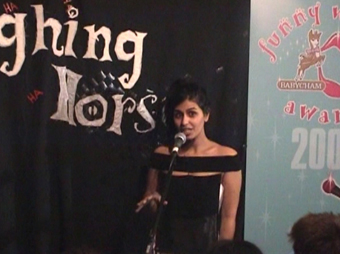 |
I’m still puzzled, because that could be a description of Billy Conolly. I consult the leaflet: “Jokes temporarily change the rules of engagement with art through the viewers’ subjective experience; their relation, connection and disconnection as sexed, raced and classed people.”
Fair play, I’m impressed by the canny deployment of language here. There’s also mention of an artist’s book, which is for sale in the bookshop downstairs. I go to check it out.
Yara El-Sherbini is a good comic, funny and acute. I listened to her set with a wry recognition that flared into a belly laugh a couple of times. The question of what might nudge a performance into Live Art territory remains. Is “Jokes and puns explore stereotype” the clincher? If she had wanted to develop an ‘Angry Landlord’ persona, or a ‘Stavros the Greek’, or if she had gone the colluding-with-audience-prejudice route, as poor old Charlie Drake had to through most of his working life, would that boost the irony/reflexivity quota of her performance (or document of her performance as it’s presented here)? Or would that subtract from it, by, I don’t know, entertaining her audience without sufficiently busting their prejudices? It’s odd, because unless she’s playing the Bernard Manning circuit, the audience isn’t going to be that shocked by her material. Tickled, of course.
There’s an edginess to stand-up that can be used to support an argument for its inclusion under the umbrella of experimental performance. The set recorded here, though, requires context. El-Sherbini is not alone among comics in playing with the evolving realities of British identity: what, besides her stated intention, separates her from others using similar material? It would be good to know, because with the rather casual, bring-your-own-context approach taken to showing the piece here, a suspicion remains that the “sexed, raced and classed” portion of her spiel may be delighting programmers all over Europe by allowing them to visibly demonstrate inclusive practice while at the same time showing work that is questionable enough, in the 'edgy' sense of the word, to be current. It’s possible Inbetween Time has enough confidence in its audience to feel such a suspicion is unlikely; but that presupposes that if the audience—or audient—were to misunderstand the intention behind showing this work, that would be their own fault for being ignorant and not recognising Art when they see it.
Conversely maybe it’s the case that reflections on the “sexed, raced and classed” nature of our being are an urgent contemporary concern, fuelled by historical processes which have been amplified by postmodern experience of hybridity. It’s curious then that this the only example of overt—let me try to remember the current catchword—“cultural diversity” in the whole festival? Then the need to place this piece within an explanatory context becomes even more crucial in order to avert any impression of tokenism.
Unhappily, the context I’m bringing to viewing this piece is 20 years observing the ham-fisted application of various exclusionary, sorry, “inclusive” policies. As far as seeing this particular work in the gallery is concerned, I wish I could come at it from a less cynical place.
At the festival opening conference a letter was read out from Daniel Belasco Rogers, who unfortunately couldn’t attend. In it, he said that he would run a mile from curators who tell you all about their newest project, and ask “Have you any new work about oranges because that’s the theme I’m dealing with this time?”
Well, for too many British Black and British Asian artists for too much of the time the opportunities are all about oranges. (I'm told it's different once you have 'made it', though looking around, I'm not so sure.) Sincere congratulations to Yara El-Sherbini for making orangeade, and sharing it with us; and I hope to have a taste of any other refreshing sparkly beverage she makes.
Avoiding dark Ali’s, Yara El-Sherbini, Arnolfini, Feb 4
Osunwunmi is an artist/facilitator working out of Bristol.
© Osunwunmi ; for permission to reproduce apply to [email protected]








 back
back